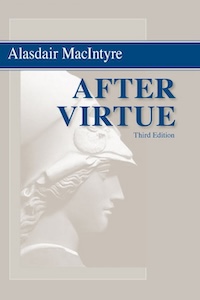After Virtue, Chapter 1
27 Oct 2025

After Virtue: A Study in Moral Theory, Third Edition
Alasdair MacIntyre
University of Notre Dame Press, 1981, 2007
This is the first of a series of notes on Alasdair MacIntyre’s After Virtue. These are just the unpolished notes I took for myself during reading. They’re pretty rough, and probably don’t make any sense on their own, but could be useful to somebody going through the book.
Chapter 1 - the thesis
Begins with an experiment reminiscent of A Cantle for Leibowitz: imagine there’s breakdown of the scientific tradition, and what future vestigial inheritances would look like.
There’d be a linguistic component: e.g., use of terms like “specific gravity” may resemble usage of earlier periods, but the beliefs presupposed are lost, thus also lending to an arbitrary appearance of the terms. AM says this is what has in fact happened to ethics and ethical language in our own time.
Because his thesis is partly historical, his investigation will be historical, and will shy away from certain kinds of philosophy since analytical and phenomenological philosophy is only descriptive.
His argument will have to demonstrate that a catastrophe occurred in history even though there is apparently no record of it, will also have to examine the historical reasons why it happened. This history will also be partially evaluative in nature. Part of the issue confronting this project is the way in which (academic) history is conducted - value-neutral, etc. - it is affected/compromised by the catastrophe.
His positive argument will be for recovering the tradition that has been lost. It is a historical tradition, so part of the argument will be an historical evaluation of that tradition to see if it coheres, and is worthy of adopting. Note that the argument will not be for any particular philosopher (e.g. Aristotle - he critiques Aristotle at points), but for the tradition as a whole, more or less as a kind of meta ethics, although he will extract specific virtues along the way.